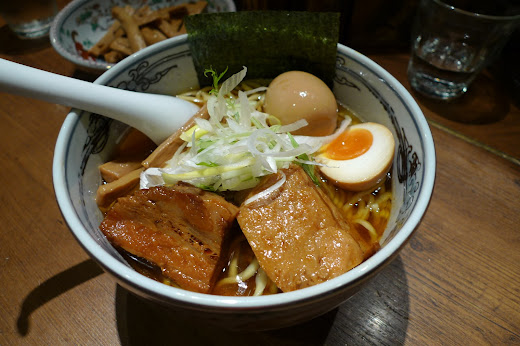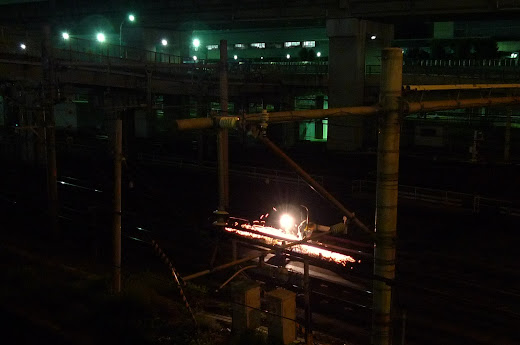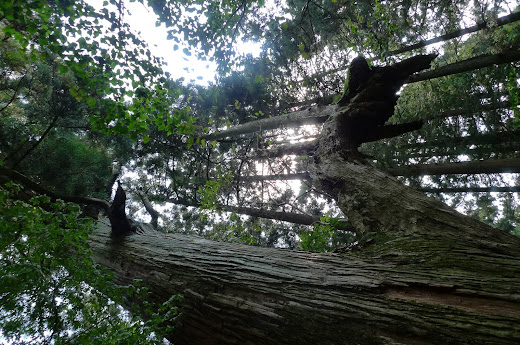I couldn't quite figure out what this sign on the other side of the tracks was supposed to mean.
The Kanda River, near Ochanomizu Station in central Tokyo.
A Russian Orthodox church in the heart of Tokyo.
Ueno Park on a chilly autumn day.
More ramen adventures:
Hakata-style ramen from Danbo in Kanda-Jinbocho.
Let it be known that this was the best bowl of ramen I had during a 16-day trip that contained far too many ramen meals. The broth was manna from the porkivore gods. The only thing that could have improved this was a soft-boiled egg, which topping escaped my attention despite being featured prominently on the menu tacked to the wall. I thereupon vowed not to make this mistake again in future ramen meals.
The Menya Musashi ramen, to be known as the Hot Bowl of Hubris.
Let's rewind a little bit: I'd spent most of the noontime hours circling the immediate vicinity of Harajuku station in search of a ramen shop I'd visited back in 2003, during my first trip to Japan. I remembered neither where the ramen shop was nor whether it was actually any good. Harajuku is famous for its dubiously fashionable wares and their corresponding hordes of teenaged patrons; in other words it is no place for a humorless and half-starved thirtysomething with an iPod stocked with latter-day Wilco albums. Thirty minutes later, I'd carved a rough circle through an unending sea of squawking humanity and decided to bail to Shinjuku.
Trying to avoid crowds by going from Harajuku to Shinjuku is a little like substituting Diet Coke for regular Coke with your Double Quarter Pounder meal. The crowd is a little older and the streets are a little wider, but it's still overwhelming. I headed off to a hip but pricey bar district called Golden Gai, in search of a ramen joint I'd had my eye on.
There are no street names in Japan, and consequently no street signs, so after another 30 minutes of trudging aimlessly through concrete jungle, I elected to cut my losses and go to Yoshinoya. But quite literally one intersection before reaching Yoshinoya, I noticed a storefront down the cross street with 麺屋 (MENYA) written on its entrance curtain. Upon closer inspection I discovered that it was a branch of Menya Musashi, one of the most famous ramen chains in Tokyo.
Inside it was bar seating only, with a line of expectant patrons stretching down the entire length of one wall. While placing my order at the vending machine, I remembered my failure at Daipo Ramen a few days earlier, and thus took special care to get a topping ticket for a soft-boiled egg. For the hell of it, I also ordered extra menma (cured bamboo strips).
The host receiving the orders asked me how I wanted my broth. "Light or heavy?" Heavy, of course. What kind of question is that? Then: "Small or large?" I put my arms out to either side and measured the length of my contempt for the idea of a small ramen bowl.
Thus, the Huge Bowl of Hubris:
- Mistake 1: the base ramen came with not only two large, melty slabs of stewed pork, but also half of a soft-boiled egg. My extra egg ticket thus made my meal the protein equivalent of a punch in the face.
- Mistake 2: the extra order of menma, at 150 yen, offered what must be the largest food-to-yen ratio in all of Japanese dining. It was a fuckload of menma.
- Mistake 3: in any ramen restaurant where the guys behind the counter look like they know what they're doing, just get the smallest amount of noodles on offer. Most of the time, the initial noodle order is free, regardless of size, but so you're kind of obligated to finish what you've asked for. If the base quantity of noodles is somehow not enough (and it is never not enough), then you can always get a refill for something cheap.
This was a damn good bowl of ramen, but it was relentless and inexorable. I felt subject to events large and beyond my control. I tried to pace myself, but by the end I resorted to the decidedly juvenile tactic of obscuring a half slab of pork and the remains of my menma (still comprising a small forest of bamboo, despite my sustained efforts) beneath a puddle of opaque broth. It was under such physical duress that I then proceeded to get lost yet again trying to get from the east side of Shinjuku station to the west, and ended up walking around the entire perimeter of what I later read was purportedly the largest train terminal in the world.
Following the Huge Bowl of Hubris, I felt as if my relationship with ramen had changed: the honeymoon having flamed out spectacularly in an orgy of fatty protein, empty carbs, and some acres of cured bamboo, what was left between me and ramen was a more mature and conflicted affection, tinged equally with resentment and nostalgia. Post-HBB, I managed just one more ramen meal, the above serving of serviceable tsukemen from a six-seat stall Chelsea and I stumbled upon in Shimokitazawa. I was still an idiot and ordered the "medium" size noodle plate, as if it was somehow close to the amount of noodles a normal human can physically eat.
Sukiyaki: strips of beef cooked in lard, soy sauce, and sugar, and then dipped into raw scrambled egg. Relative to certain other meals I've had on this trip, this counted as a tasteful and restrained lunch.
In a deliberate attempt to experience The Best Sushi I Will Ever Eat, I sprung for the 16000-yen omakase at Karaku in Ginza. Karaku serves sushi in the edomae style, which means that the fish is usually adorned with a small amount of sauce or seasoning. As such I didn't bother with the little dish of soy sauce you usually get with sushi.
So as not to appear as some kind of asshole, I will refrain from waxing poetic about this meal. Suffice it to say the following: it was indeed the best sushi I will ever eat, but not quite the linear extrapolation of mind-blowing flavor one would expect for the listed price, but anyway the price wasn't the point.
Katsuo sashimi (bonito), daikon, and green onion. Slightly tangy.
Miso with clams. Not salty. Very clammy.
Salad: cucumber, daikon sprouts, katsuobushi, sesame seeds.
Top to bottom: hirame (summer flounder), maguro-zuke (pickled tuna, glassy texture, candy-like), tai with goma (red snapper with sesame dressing).
Left to right: hotate (scallop, crunchy), kohada (gizzard shad), ika (squid, even crunchier). I couldn't taste much on this plate except for fresh-grated wasabi, which made me cry.
Sanma (Pacific saury), seared, with nice "rare"-looking flesh. Not pictured, because I suck at food blogging: kazunoko (herring roe). Like chewable plastic, if plastic was tasty.
Toro (tuna belly). Okay, look: it tasted about what you think toro should taste like at a great sushi restaurant.
Ikura (salmon roe). The individual eggs burst open when chewed, which made this a little like eating tiny fruits.
Anago (saltwater eel). Similar to unagi, its frequently-barbequed freshwater cousin, only less sweet, and with a cake-like consistency.
Tai skin. Bacon-like. Let's just say they saved the best nigiri for last.
Cucumber rolls which were more like wasabi rolls, and negitoro maki (toro with green onion).
A chaser of tamagoyaki (folded custard-like egg) and pickled daikon.


































































